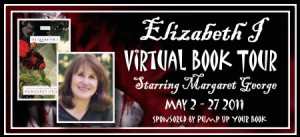
Please join me in welcomingMargaret George, author of Elizabeth I to Always With a Book! If you missed my review, you can read it here. Today Margaret guest blogs about choosing which voice to use in writing.

Finding Your Voice—Writing in the Third Person—or First?
Big choice—major fork in the road—third person or first? If you choose wrong, you’ll have to go back and start all over. They each have their strong points and their limitations but in the end you need to decide which will tell your story better—hopefully without having to write it both ways just to find out.
When I was starting out, the first person was totally out of favor. I was told no one wrote first person. It was true that some classics were written in the first person—The Catcher in the Rye, Moby Dick, The Great Gatsby—but it was thought either too difficult or too confining to be used in most modern stories.
But for the story I wanted to tell—what went on in the mind of Henry VIII when he behaved so outrageously—only the first person would do. Otherwise the reader is still standing outside and looking on, bewildered.
The first person is deceptively easy at first, because it seems the most ‘natural’ way of writing. It’s the way we think and talk, after all. But it’s full of pitfalls. Its very ‘naturalness’ proves an excuse to sloppiness, to a feeling that this must be convincingly real because it’s written as “I.” But it takes genuine craftsmanship to make it real.
Generally the first person should be used when you already know what happened, but you want to know why. Or you want to spend a lot of time inside someone’s head and it isn’t an inconvenience to be stuck there, to be limited to seeing and hearing only what that person sees and hears. Obviously Henry VIII needed to be first person. So did Helen of Troy—we all want to know what it felt like to be the most beautiful woman in the world and to cause the most famous war in the world. First person cannot be beaten for immediacy and verisimilitude.
Mary Queen of Scots as a character challenge was totally different, in that so many things were happening simultaneously elsewhere that impinged on her and the reader needed to know. The third person was needed here. The third is good for suspense, because you can show two different frames and know what each side has at stake. There were many plots, and many villains and many other spies and two-faced people, and Mary was ignorant about a lot of it. Irony, scene changes and machinations are best handled by the third person.
By this point in my career, the first person viewpoint was making a comeback, and today so many historical novels are written in the first person. One way around the limitation of vision to one character has been to have two (or sometimes more) first person narrators, which gives extra perspective. Multiple voices or narrators can also be used in the third person, but that can get very busy.
Just as you are naturally left or right handed, you probably are stronger in one or the other viewpoint. It’s good to be able to do both in case you run into material that insists on one or the other, but you will obviously gravitate toward either first or third.
Often afterwards a reader doesn’t remember whether a book is first or third person, but if viewpoint is used correctly, it should be such an important element of the book that you can’t imagine it written any other way, and it’s an invisible part of the story.

About the author: Margaret George is the author of six epic biographical novels, all New York Times bestsellers, featuring larger than life characters like Henry VIII and Cleopatra. Although painstakingly accurate historically, their real focus is the psychology of the characters. We know what they did, we want to know why. Her latest release is Elizabeth I.
Margaret’s research has taken her from the islands of Scotland to the temples of Upper Egypt, with experiences that include snake-keeping and gladiatorial training.
She lives in Wisconsin and Washington DC. Interests include reptile conservation efforts, Middle Eastern dance (aka bellydancing), and archeology.
You can visit Margaret George’s website at www.margaretgeorge.com.
Thank you Margaret for contributing this great guest post, and thanks to Cheryl at Pump Up Your Book for coordinating it.
Thank you so much for reviewing my ELIZABETH I. I am glad you enjoyed it. And thanks for having me as a guest on your blog.
Margaret George
@Margaret Thank you for writing such an incredible book and for taking the time to visit my blog!
Excellent guest post. Thanks for hosting Margaret today.